 Nov
24
Nov
24
Top 5 Running Shoe Foams to Consider While Buying a New Pair
- 24 November 2025
- 0 Comment(s)
If you have made up your mind to buy a new pair of shoes, ensure you also look out for the material. Select a comfortable, light material, such as running shoe foams. Shoe foams are a trade-off among weight, longevity, and power; thus, understanding these is relevant. Studies indicate that improved foams like PEBA and A-TPU provide significantly higher energy payback than regular EVA, and that lightweight designs can be used to increase running economy, with a 1% decrease in performance resulting in a 100g loss per shoe. In order to make smart decisions on what to buy, find out what each foam does and who each foam works best with.
What Are Running Shoe Foams?
Running shoe foams are materials used in the soles of running shoes to cushion, absorb impact, and return energy to the runner. They include current super-foams, such as PEBA (light and bouncy) and A-TPU (durable and bouncy), as well as traditional EVA (soft and cheap). Density, compression set, and stiffness are increased or reduced by manufacturers so they can be customized for training, racing, or trail use. To serve its intended purpose, a good foam balances stress absorption, responsiveness, and longevity.
Types of Running Shoe Foams
Compressed Molded EVA
The traditional midsole foam is called EVA (ethylene-vinyl acetate). It is reasonably padded, lightweight, and fairly priced. Compression-molded EVA is used in a lot of everyday trainers to combine value and comfort. For everyday miles, EVA offers consistent cushioning and a forgiving ride. Although it can permanently compress after prolonged usage, it compresses under load and recovers (compression set).
Who is it for? Recreational runners, beginners, and those wanting reliable cushioning without a premium price tag.
Thermoplastic Polyurethane (TPU)
TPU foams (including A-TPU variants) offer a springier, more durable ride than traditional EVA. They retain performance across temperatures better and resist long-term compression. Sources point to TPU and A-TPU as strong choices for sustained performance. (See RunRepeat). TPU delivers higher energy return and consistent cushioning over many miles. It’s often used in performance trainers and some “super shoe” midsoles.
Who is it for? Runners seeking a responsive feel during long training runs or those who want longevity with a lively ride.
Polyether Block Amide (PEBA)
PEBA (marketed as Pebax in many shoes) is a top-tier foam famed for being ultra-light and highly elastic. It is a common choice in race-day and flagship models for its propulsive, bouncy feel. (See Supwell and RunRepeat). PEBA offers excellent energy return and a lively toe-off that helps with speed. However, some PEBA foams show a narrow “peak” mileage window where they feel their best before beginning a gradual performance decline.
Who is it for? Speedwork, race day, and runners who want the best running shoe foam for responsiveness.
Dual-Density Midsole
Many shoes combine two or more foams: a softer layer for comfort and a firmer layer for stability and propulsion. This dual-density approach tailors cushioning and control across the foot. Blended systems balance comfort, stability, and energy return. For example, a soft EVA top layer with a firmer TPU or PEBA core can provide plush landings and a lively push-off.
Who is it for? Runners wanting a versatile shoe for mixed training, long runs, plus tempo sessions, without sacrificing control.
Supercritical EVA Foam
Supercritical or gas-infused EVAs use microbubbles introduced during manufacturing (e.g., nitrogen) to reduce foam density and improve cushioning and rebound. These super foams often sit between standard EVA and PEBA in performance. Lighter than traditional EVA with improved bounce and softness. They offer a cushioned ride similar to premium foams at a lower cost than PEBA.
Who is it for? Runners who want a soft, buoyant ride for long distances or recovery runs without the price of full PEBA models.
The Bottom Line
Knowledge of running shoe foam types enables runners to align shoe technology with objectives. The foam option affects comfort, speed, durability, and cost. Test shoes on different runs and factor in your weight, average distances, and speed. Dribbling between PEBA race shoes and either a TPU or a sophisticated EVA trainer provides optimal speed and durability for a variety of runners.
TD Sportswear suggests selecting the appropriate running apparel and shoes that fit your training load and biomechanics. The choice of the right foam can provide joint protection, increase comfort, and enhance performance; therefore, choose carefully, experiment with confidence, and run smarter.
Frequently Asked Questions About Running Shoe Foams
What is the best foam for running shoes?
“Best” depends on goals. For race speed and energy return, PEBA or A-TPU is the top choice. For everyday training, advanced EVA or TPU blends strike the best balance of comfort, durability, and cost.
What’s the difference between soft and firm running shoe foams?
Soft foams cushion impact and reduce fatigue; firm foams stabilize and improve propulsion. Heavier runners or those needing stability often benefit from slightly firmer midsoles.
Are super shoe foams better for long-distance running?
Yes, super shoe foams (PEBA/A-TPU) improve running economy and can help in long races, but they may cost more and behave differently over very long training loads.
What types of foam are used in running shoes today?
Common types include EVA, TPU, PEBA, dual-density blends, and supercritical- or gas-infused EVAs, each tuned for different performance goals.
